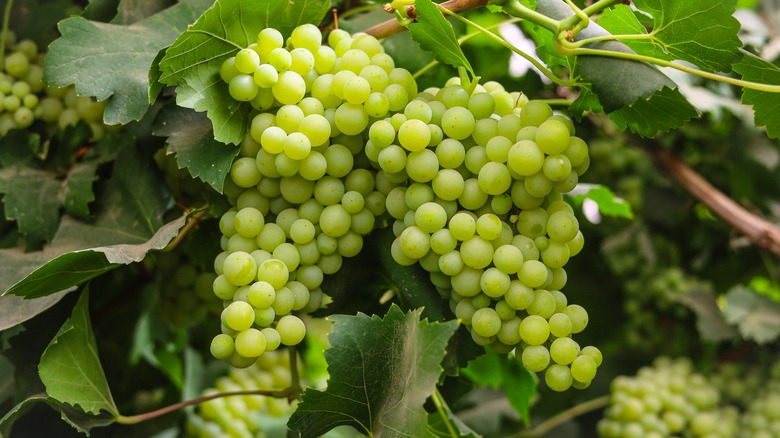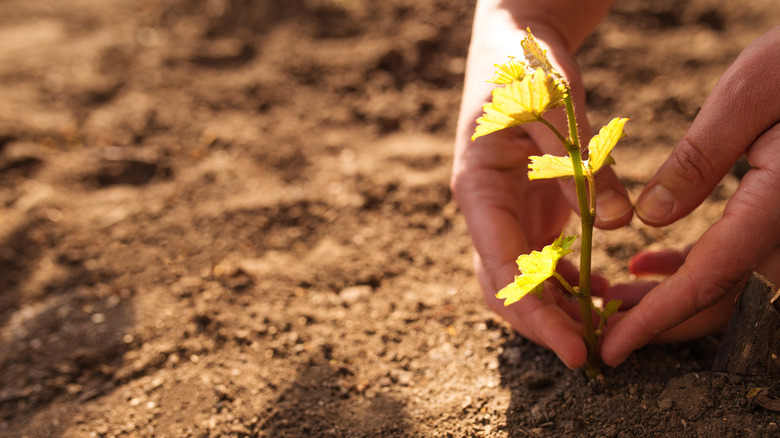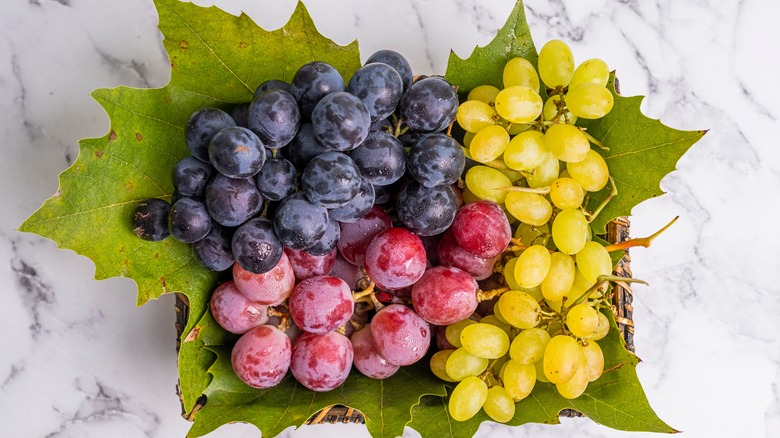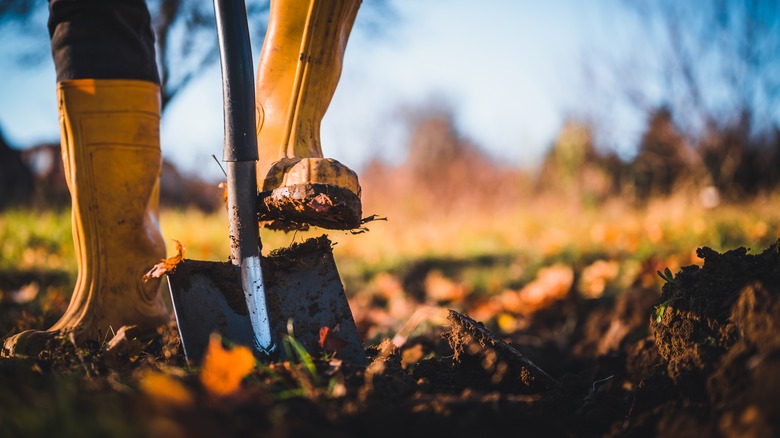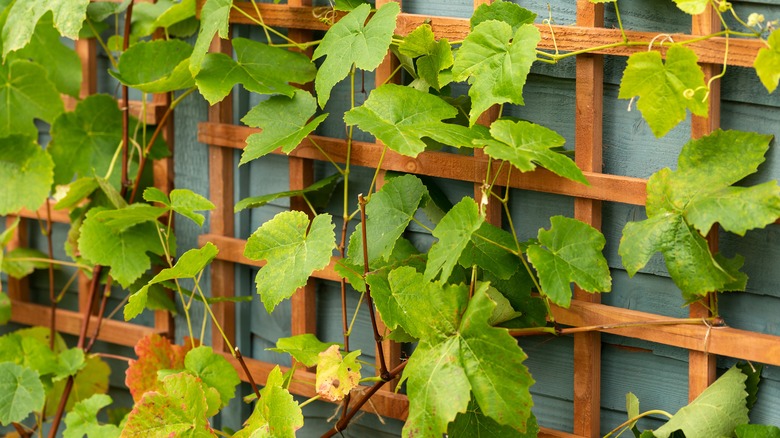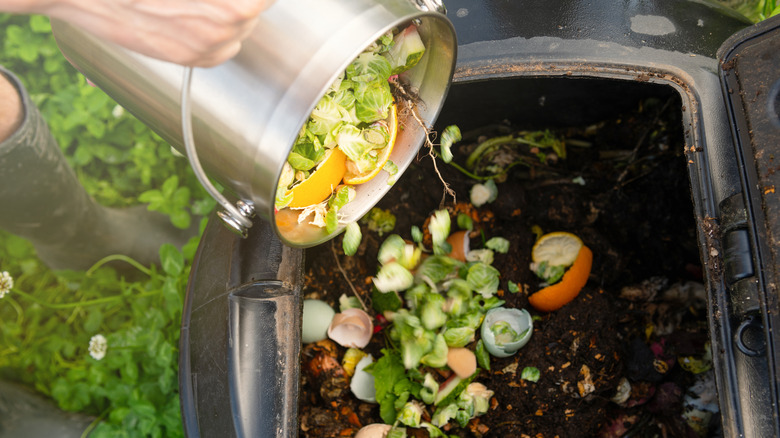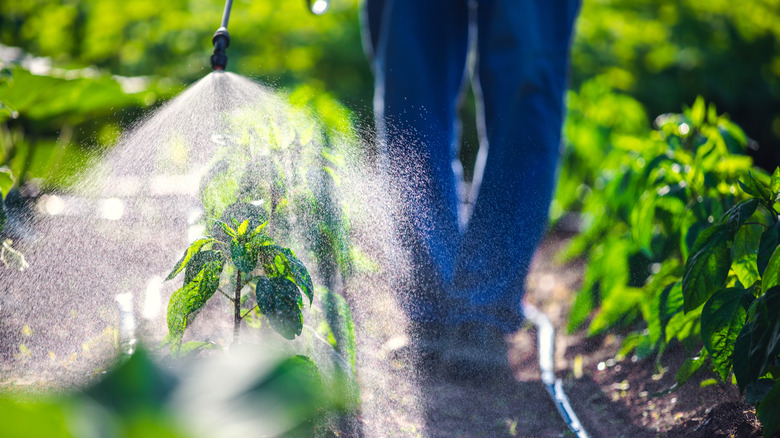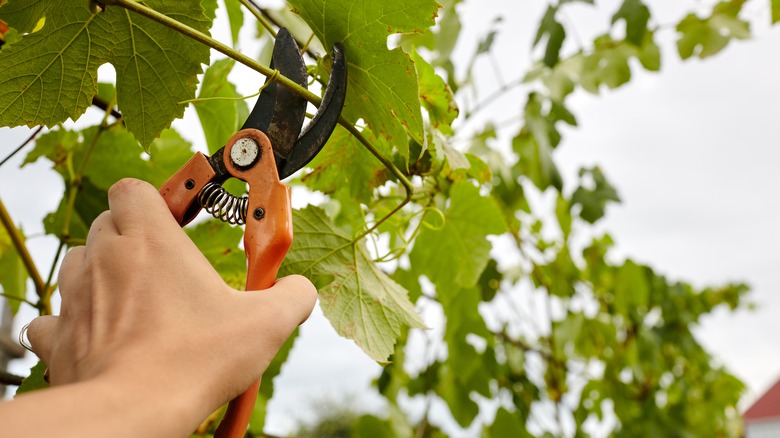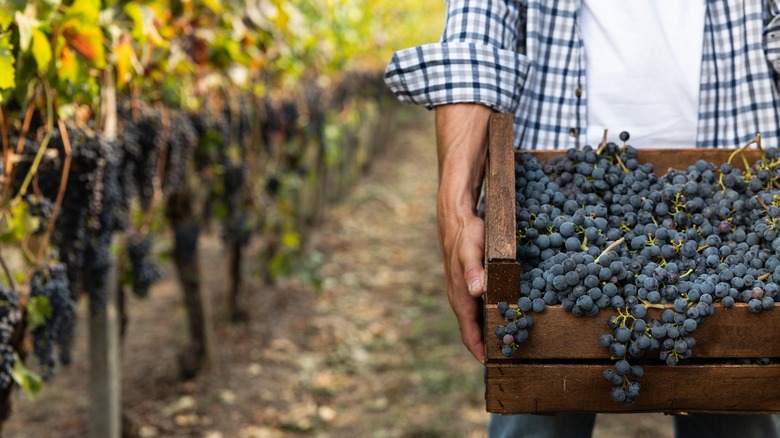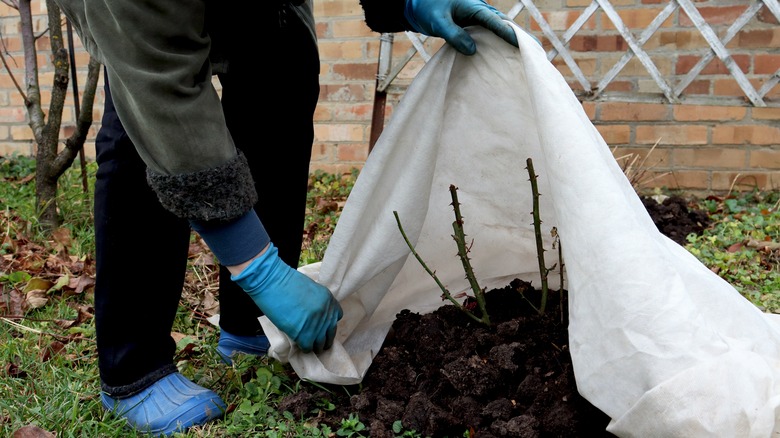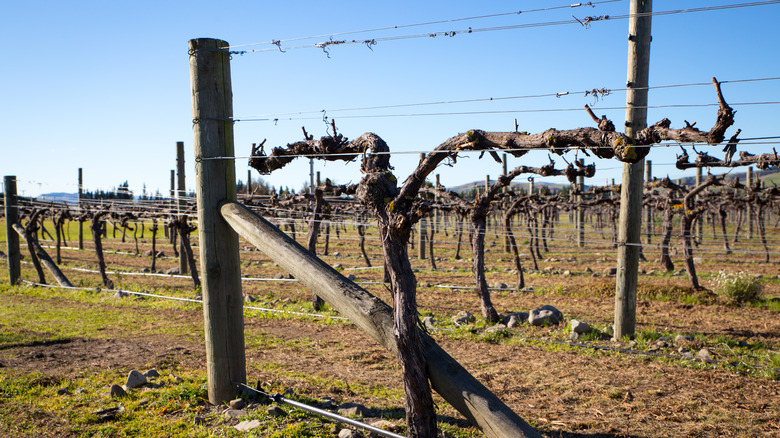Everything You Need To Know About Growing Your Own Grapes
You don't have to be a vineyard professional to have homegrown grapes. Grapes have become popular everywhere, expanding beyond the usual places, such as Europe and California. Learn how to grow a garden of grapes in your own backyard and enjoy the fruits of your bounty. There are so many benefits to growing food outside other than the fact that we get to eat fresh fruits and veggies.
Gardening outdoors helps fight disease thanks to the vitamin D we get from being out in the sun. It can relieve stress as we get busy playing in the dirt and breathing fresh air, and according to a study from the National Library of Medicine, grounding, which is the act of connecting our bodies physically with the earth, may have cardiovascular benefits. So go ahead and start planting your garden of grapevines. Go barefoot every chance you get and ditch the gloves while digging in the dirt. Your body will thank you for it.
Why grow grapes?
Grow grapes for the same reason you should grow any fruit or veggie – they're packed with vitamins and you can use them to create fabulous homemade dishes. Jellies, juice, and of course, wine can all be made from these juicy little globes.
According to Healthline, grapes are jam-packed (pun intended) with antioxidants like vitamin C, vitamin K, and potassium. They also tell us that grapes keep us hydrated because they contain water. Obviously, growing grapes is an excellent idea.
After you've had your share of eating fresh grapes right from your garden, you can use the canning method for jams, jellies, and any other type of sauce you may like to make from your grapes. You can also seal grapes in a freezer bag or container for up to one year. Wash grapes first, then lay them in a single layer on cookie sheets to freeze in your freezer. Once frozen, remove the tray and add the frozen grapes to your containers. Using this method helps keep the grapes from sticking together as they freeze.
Grow grapes in any climate
According to eVineyard, grapes thrive in warmer climates that have long, hot summers and rainy winters rather than snow. That type of environment helps the vines to flower and ripen. Does that mean no grapes for those living in the north? Not at all. You can still have your grapes; you'll just need to take some extra steps. As a matter of fact, according to Michigan.org, with over 13,000 vineyard acres in Michigan, the state is home to popular grape varieties, such as Niagara and Concord. The secret is the Great Lakes, keeping frosts at bay in the winter and insulating the plants with snow during freezing temperatures.
You can truly grow grapevines in any state. Actually, there is at least one winery in each of the 50 states, and wine doesn't happen without the juice of our friend, the grape. Still, pay attention to what zone of the state you live in and choose the right plants accordingly. Some are hardier than others.
Prepare the soil
To get the best harvest of grapes, the vines need fertile soil that drains well. The fascinating thing about soil is that grapes will grow in all kinds; they'll just produce a different type of wine according to the soil. The color, tannins, and taste all change depending on the soil. Still, some soils are simply better for growing grapes than others. According to Sommeliers Choice Awards, loamy soil is the perfect soil. Loam soil is an equal mix of sand and silt, along with clay. The clay is great for retaining soil moisture and contains nutrients and water, which are good for plants.
We don't all live in areas with loamy soil, so instead, if you want to grow grapes, you need to prepare the soil. Before doing anything, make sure the soil isn't too wet or frozen. First, you'll need the soil to be at least two feet deep, though three to four feet deep is preferred. Use a large amount of compost (2 inches deep) if the soil doesn't drain well. Poor drainage leads to disease. If you live somewhere where the soil isn't deep or it's just all hard clay, raised garden beds are a good option.
Choose your grape plants
You can't simply choose any grape plant. Each variety fares well in the right climate for that grape. Choose the correct plants for where you live. Each area of the country has a different climate zone. There are nine altogether in the U.S., and they range from two to ten, with number two being the coldest. According to Monrovia, grapes can be grown in any zones from 4 – 10. With three basic varieties, American, European, and Muscadine, there's a grape for every area.
Choose American for colder climate zones (4-7), European for the warmer, dry climates (7-10), and Muscadine for the grapes that love heat and humidity (zones 7-9). You'll also need to know how you want to use the grapes. The American varieties are known as table grapes and are best for snacking, canning, or some homemade grape juice, while European and Muscadine are excellent for winemaking as well as eating as a table grape.
How to plant your grapevines
For a good size crop of grapes, you need a lot of space. Grapevine plants should be planted 6 to 10 feet apart, and each vine should have a hole that's 12 inches wide and 12 inches deep. Be sure to choose the best time of year for planting. In the U.S., that's late winter or early spring. Don't wait until the hot summer sun is beating down. If you can choose a time of day, get out and plant early in the morning, late in the day, or wait for a cloudy day.
When you receive your new grapevines, plant them as soon as possible. Storing vines isn't good for grape production. If you're transplanting vines that have already taken root, do it carefully. It's not an easy undertaking. According to Gardening Know How, grapes have very deep root systems and are difficult to transplant. However, you can take cuttings in late winter, root them, and then transplant them wherever you 'd like them to grow. Propagating grapes this way is easier than moving a mature plant. Fertilize, compost, and water as needed.
Train the grapevines
As grapevines begin to flourish, thanks to your amazing gardening skills, you'll need to train the plants so they grow well and produce more grapes. Leaving them untrained will cause them to fall to the ground and become damaged, leaving you with a small yield.
Training a plant means you're helping it grow in the right direction. Vines spread and training them helps them grow upward rather than across the ground. When vines are just starting out, you can simply stake them to help them grow straight up. However, it won't be long before you'll need a trellis to allow the vines to really climb.
According to Rural Sprout, grapes are survivors. The vines can live and continue to produce for up to 50 years, even when left to their own devices. They'll climb anything they can, whether it's a trellis, a wall, or a tree. Still, a trellis is the best choice and it's easy to make one at home using fence posts and wire. You can also let grapevines climb a pergola for a stunning trellis.
Fertilize for healthy plants
Thankfully, grapevines don't need a lot of fertilizer. Your best bet is to make your own compost. That's all the grapes need. The dictionary defines compost as, "decayed, organic material used as a plant fertilizer." Building your own compost is easier than you may think. The decaying process takes care of itself. You just have to give it the right environment to do so. Choose a small area in your yard, about 3x3 feet, and fence it off as your compost pile. Save food scraps in a bucket throughout the day and dump the bucket directly on the ground of your composting spot at the end of the day. You can also buy composting bins that spin and aerate your compost if you prefer to not have it right on the ground.
Composting is good for the environment as well. Darby Hoover of NRDC, explains, "Compost adds nutrients and organic matter back to soil, which benefits agriculture, reduces our reliance on synthetic fertilizers, diverts methane-producing organic materials from landfills, and improves soil's water retention capacity so you don't need to water as much." Spread one inch of composting material around the bottom of your grapevines in early spring and again in the fall after harvest. For poor drainage areas, use two inches of compost.
Water and weeding
Water grapevines near the roots rather than right on top of the fruit. Grapes don't like a lot of rain or water so don't overdo it. For new grapevines (first two years), make sure they're getting ½ to 1 inch of water a week (about five gallons). Once a vine's trunk is mature, after two years, you probably won't have to water as long as they are getting rain now and then, according to the University of Minnesota Extension.
Weeds are the nemesis of any gardener. Your grapes will grow even if weeds are around them, however, they'll grow much better without them. Weed regularly so it isn't such an undertaking every time. According to The Middle-Sized Garden, it's best to weed garden plants from March – June. After those months, weeds slow down. Dig weeds out using your hands or a garden shovel and make sure to get the roots. Once an area is cleaned up well, use some mulch to help keep weeds at bay.
Prune the vines
Although most gardeners are anxious to eat and enjoy what they've planted, it's best to be patient with your grapes, and not allow them to produce the first year. The wait is worth it as your plants will produce bigger, healthier grapes because of it.
According to Minneopa Orchards, pruning encourages growth where you want it in the vine, increases productivity and fights disease, and allows the vine to concentrate its energy on producing fruit during the growing season. Prune grapes when they've gone dormant in the winter. The goal is to cut away old wood from the vines and leave at least two buds on the wood that's trimmed back. Many grape growers like to train their vines to two wires on their trellis. They allow two shoots from the vines to expand across each wire, one on top (5 feet from the ground) and one on the bottom (3 feet from the ground). The shoots that grow in between are removed, allowing all the growing energy to focus on the two shoots that are trellised.
Harvest and storage
Finally, after many months of tending to your grapevines, it's time to harvest and store up your long-awaited grapes. Grab some scissors or garden pruners to get the job done. Look for a mature cluster of grapes and hold it in your hand, then simply cut off the cluster with your shears. Wash and eat immediately for the freshest grapes you've ever had. Hopefully, there's an abundance and you'll have to find ways to save the excess fruit.
According to My Recipes, to help your table grapes remain fresh, don't wash them until you're ready to enjoy. The excess moisture speeds up the decaying process. They also recommend keeping grapes away from direct cool air, as it speeds up dehydration.
Freeze the grapes you can't use quickly, or can them. Can whole grapes just as you would any other fruits. Remember canned fruit cocktail, with the squishy grapes? That's the result you'll get, along with a little nostalgia. And of course, you can try your jam-making skills with grapes and have beautiful jars of canned jam each morning for your toast.
Protect your plants in winter
Grapes aren't fans of being cold. Although, in some areas they can make it through the winter, even with snow, it's best to protect them. An easy method is to use mounds of dirt, mulch, or straw, and add a thick layer at the bottom of each grapevine trunk. According to Lakeland Yard and Garden, you can also use covers on your plants to keep them warm. They suggest covering the entire plant with a breathable sheet, blanket, burlap sack, or drop cloth. Place the cover loosely over the grapevine and stake it to the ground, leaving enough space so the plant's foliage isn't crushed. The cover helps hold the heat in around the plants.
Sometimes, drastic measures are taken if a severe winter is expected. Vines are cut down, clustered together, and buried in the soil for warmth until they can be replanted. Even with protection, make sure from the beginning, you've selected a variety of grapes that can handle the colder temperatures.
Common pests and diseases
Things like mold, rot, mildew, and pesky pests can ruin a grape harvest. It's important to do your best to ward these things off. According to WikiFarmer, common grapevine pests are Phylloxera, which is an aphid that destroys the root system, and the Japanese Beetle, which hibernates in the soil all winter and then attacks in the spring. Two more are the European Moth, which eats the leaves of the grapevine, and the Grape Berry Moth, which lays its eggs on flower clusters, wreaking havoc. To control pests, turn to chemical or natural pesticides.
Like any plant, the grapevine is prone to many diseases. The most common are downy mildew, powdery mildew, and grey mold. Keep diseases away, or at least do the best you can by using mulch to hold in moisture, don't water overhead, but instead at the roots, and keep shoots pruned so there isn't overcrowding. The shoots get better air circulation when not overcrowded. If disease should strike, just remove the damaged areas.
Caring for plants after harvesting
Grapevines go dormant after harvesting but they still need care. It's important to continue managing disease, providing moisture and fertilizer as needed. As dormancy begins, cut away any grapes that have dried up. Prune, so in the spring, the vine can focus on growing only two shoots. Check the vines daily for pests and disease while dormant, and of course, apply your cold-weather protection when needed.
It's easy to panic, wondering if your grapevines are dead. They don't look as beautiful when dormant, compared to when they are producing grapes. Don't worry. According to Growing Produce, when the vine is dormant, all above-ground growth comes to a halt. However, while no longer focusing on the growth of fruit, the vines are using all their energy at the root system. The roots take off underground, soaking up nutrients and preparing for a fruitful harvest once again after the winter and spring.
Sell the abundance
If all goes well, eventually you'll have more grapes than you know what to do with. It doesn't take much to start your own grape business if you have the space to keep expanding. The easiest way to share the abundance is through your local farmer's market.
Farmer's markets are places where professionals and novices alike sell their goods. People will appreciate your hard work and the fact that they know where some of their food is coming from: Your very own backyard. Plus, you can make a little money for your efforts. According to Powered by Plenty, consumers flock to farmer's markets more than ever because they want to know where their food is coming from. They also feel strongly about supporting local farmers and local businesses, and most of all, they want fresh, healthy food. If your grapes produce such an abundance, you can now consider yourself a vineyard manager and set up local delivery of fresh produce (or just your grapes) during peak season.
